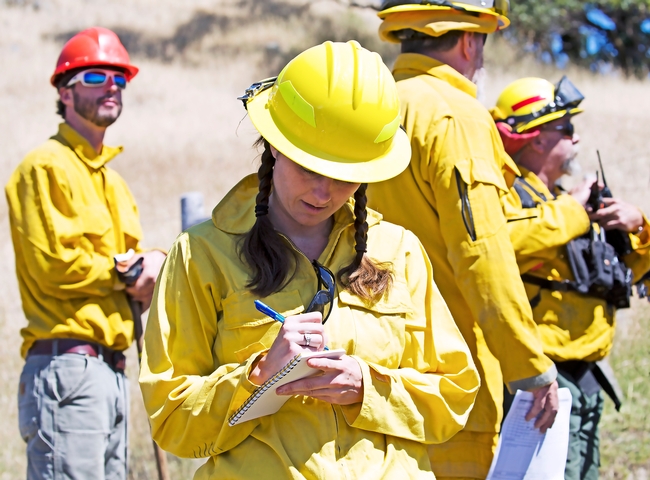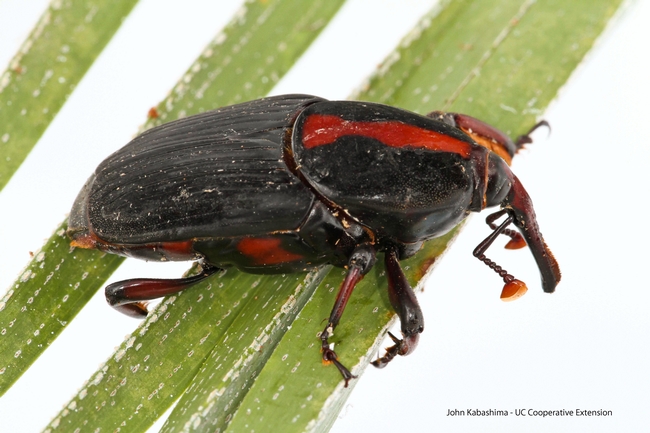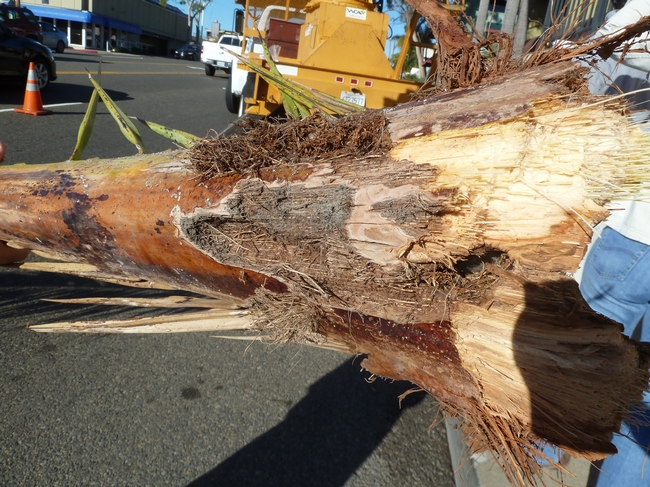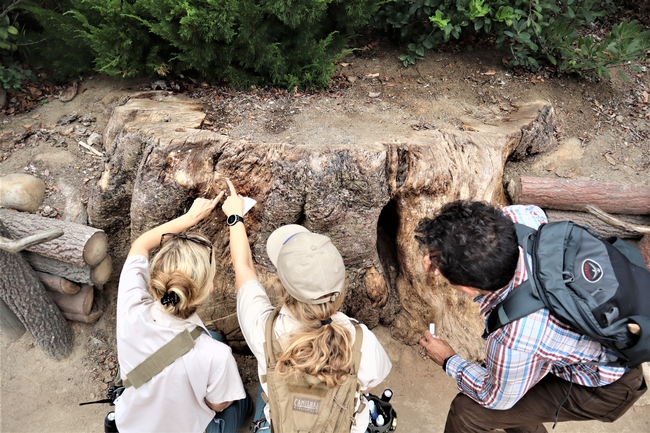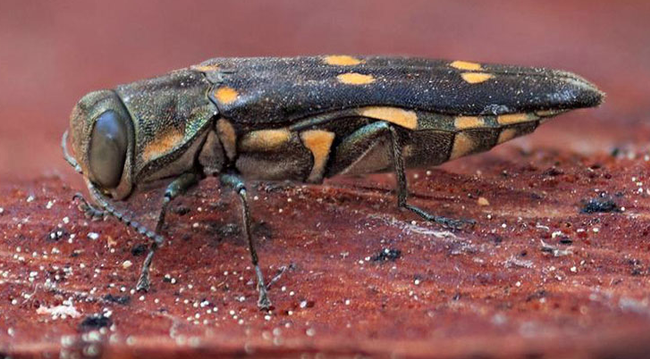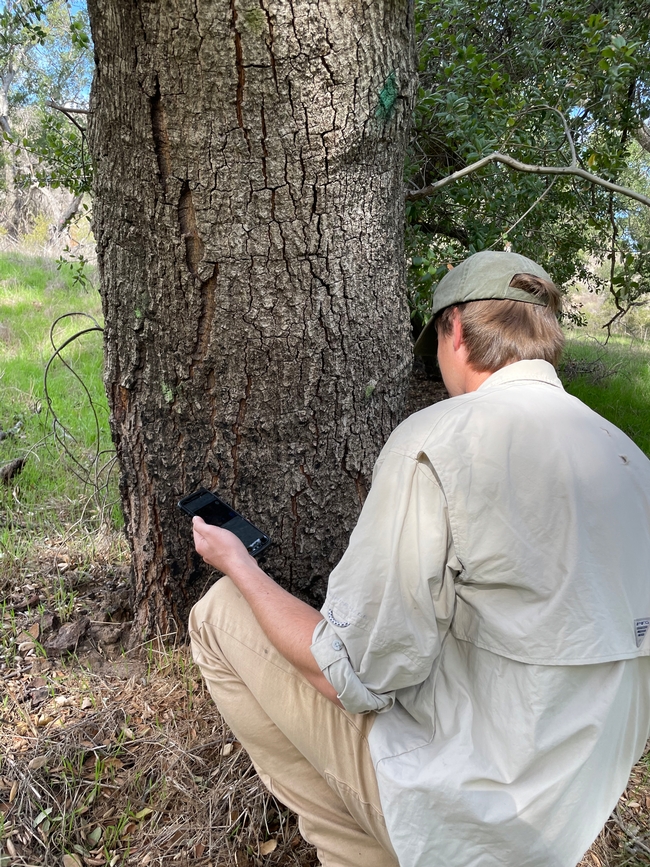Posts Tagged: statewide
Those Goofy-Looking Cartoon Characters Called Crane Flies
Back in April of 2021, we wrote: "They're out there, and you don't have to crane your neck to see them." The topic: crane flies. They're often...
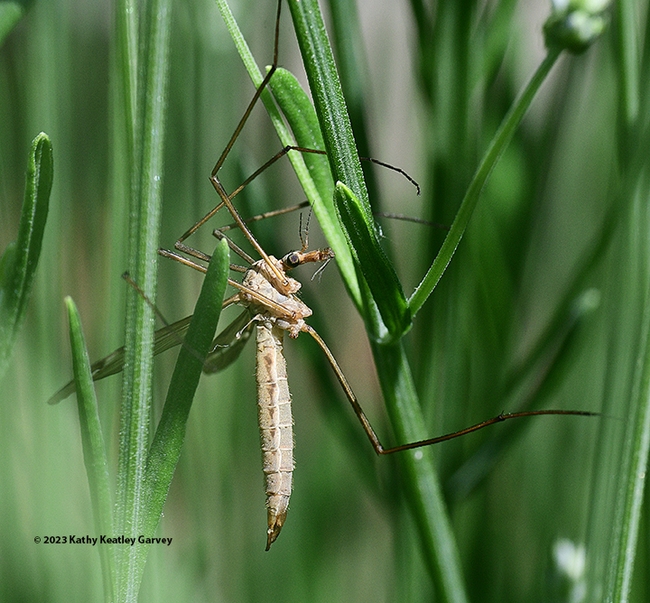
A crane fly resting in a Spanish lavender bed in Vacaville, Calif. Crane flies are sometimes called "mosquito eaters," but they do not eat mosquitoes. (Photo by Kathy Keatley Garvey)
Of Lady Beetles and Green Fruit Beetle Larvae
Make way for the beetles! Lady beetles, green fruit beetle larvae, and stick-on bug tattoos drew inquisitive and appreciative crowds when the UC...
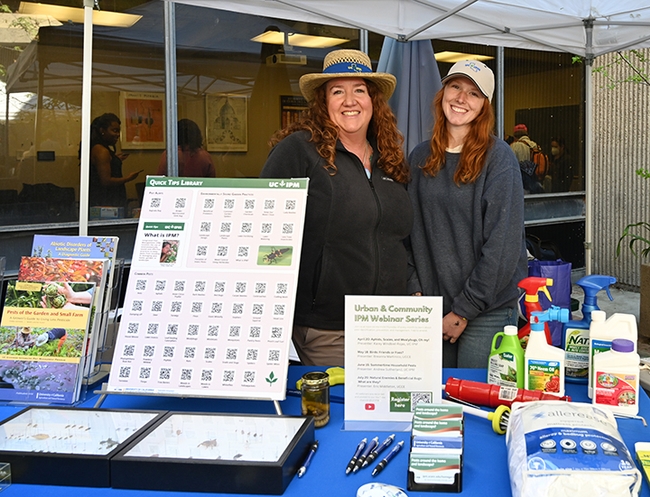
Ready to field questions are these representatives of the UC Statewide Integrated Pest Management Program: Karey Windbiel-Rojas (left), associate director for Urban and Community IPM/Area IPM Advisor, and IPM educator Lauren Fordyce. (Photo by Kathy Keatley Garvey)
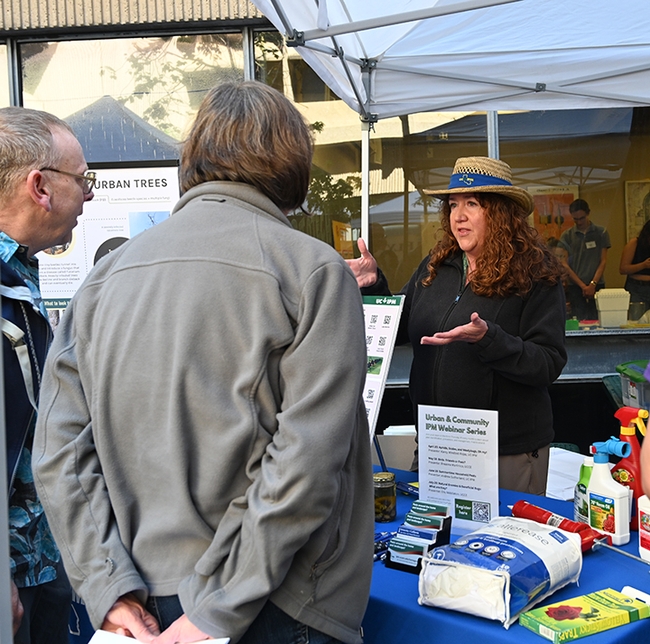
Karey Windbiel-Rojas, associate director for Urban and Community IPM/Area IPM Advisor, answers a question. (Photo by Kathy Keatley Garvey)
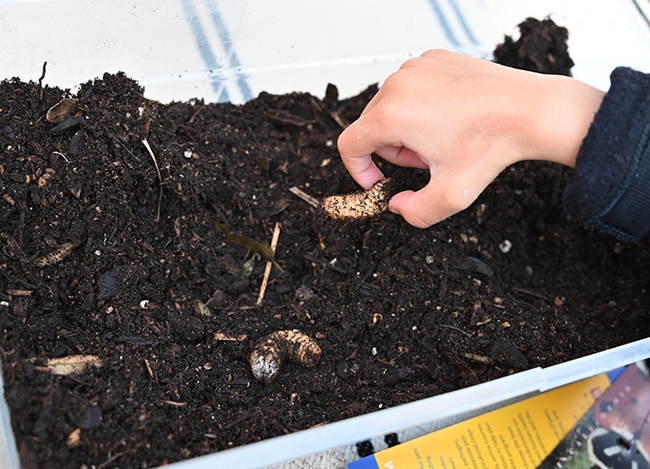
Youngsters and adults alike enjoyed watching and holding the green fruit beetle larvae. (Photo by Kathy Keatley Garvey)
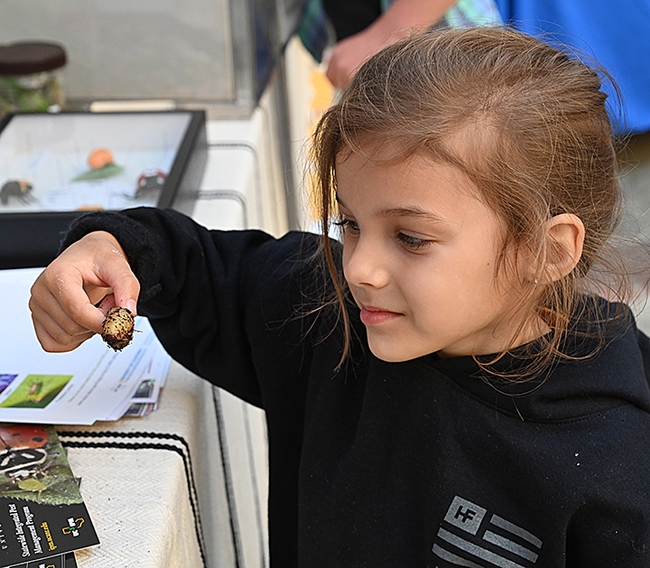
Teagan Pelusi, 4, of Pleasant Hill, is fascinated by a green fruit beetle larva. "We love learning about bugs," said her father Christopher Van Steyn, as the larva captivated her interest. (Photo by Kathy Keatley Garvey)
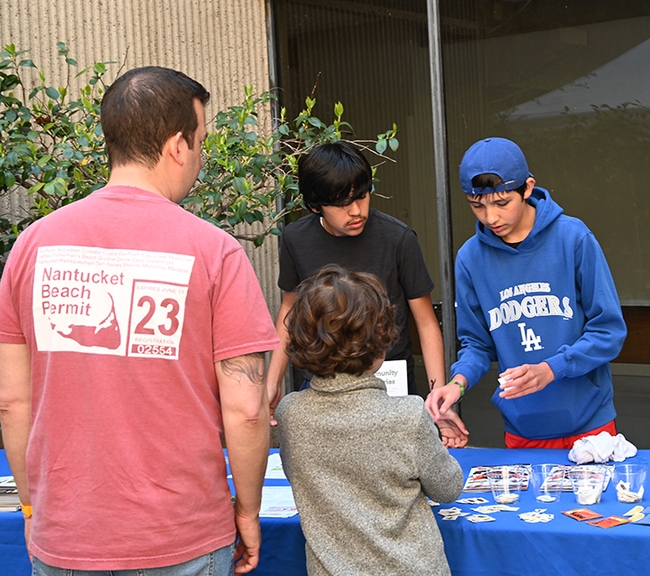
Diego Rojas (left) and his brother, Spencer Rojas, offered information about invasive pests as they gave away stick-on (temporary) tattoos. Their mother, Karey Windbiel-Rojas, a UC IPM administrator, was at an adjacent table. (Photo by Kathy Keatley Garvey)
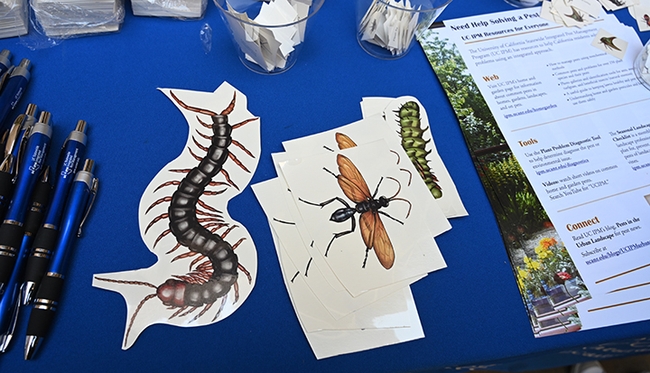
Guess the stick-on tattoos? From left are a Chinese red-headed centipede (Scolopendra subspinipes mutilans); a tarantula hawk (Pepsis heros); and a hickory horned devil caterpillar of a regal moth (Citheronia regalis). (Photo by Kathy Keatley Garvey)
Lady Beetle Lovers, Unite!
Luck be a lady! Little kids love selecting lady beetles, aka ladybugs, at the UC Statewide Integrated Pest Management (UC IPM) booth...
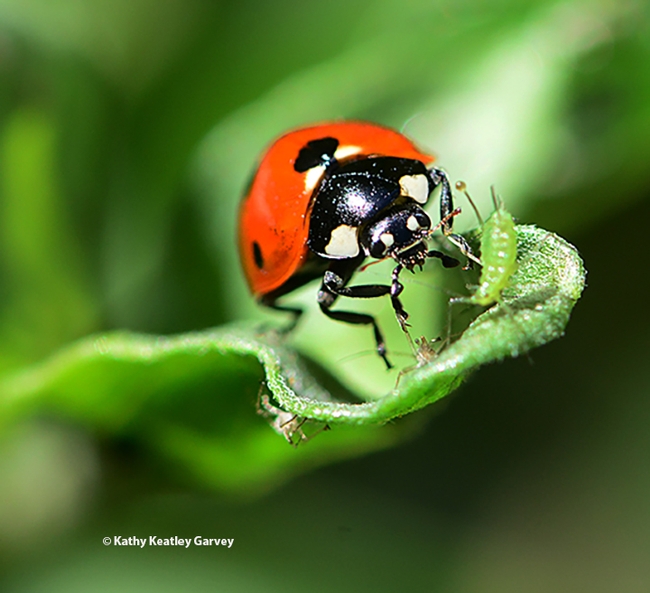
A lady beetle, aka ladybug, gets ready to devour an aphid. (Photo by Kathy Keatley Garvey)
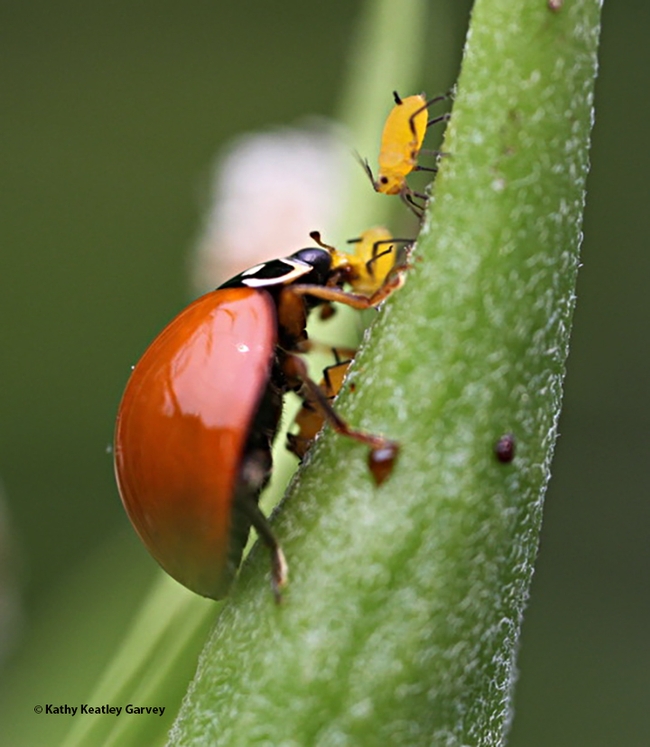
Get in line! A lady beetle devouring oleander aphids. (Photo by Kathy Keatley Garvey)
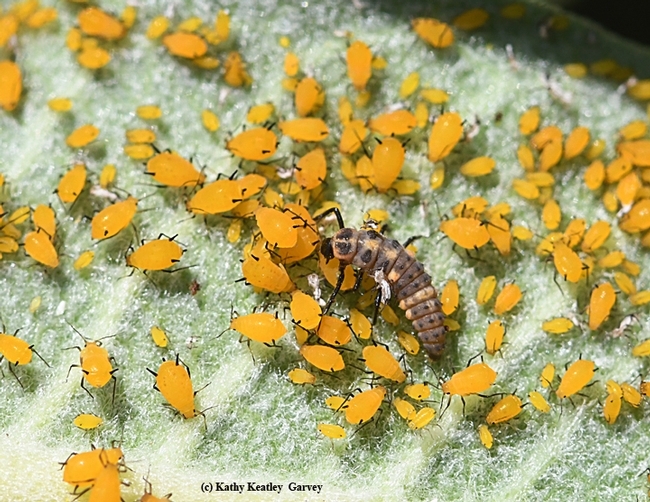
The larvae of lady beetle devour aphids, too. (Photo by Kathy Keatley Garvey)
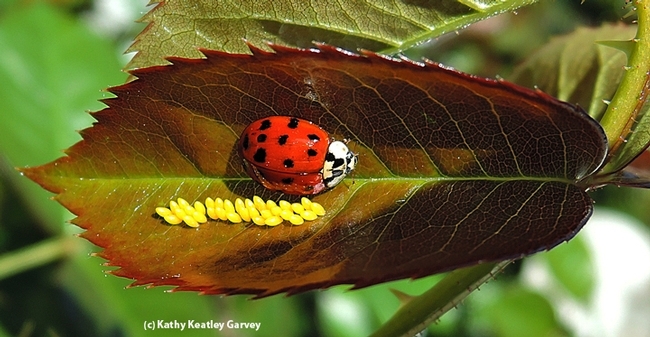
A lady beetle and her eggs. (Photo by Kathy Keatley Garvey)
UCCE seeks statewide input to develop future wildfire programs
University of California Cooperative Extension has recently expanded their team of fire advisors and staff. This new group of UCCE fire professionals is interested in learning about the concerns of the communities that UCCE serves, as well as the natural resource professionals already working to address these issues.
Results from this survey will enhance the team's ability to partner with residents, landowners, agencies, academics, and other organizations to reduce California's vulnerability to wildfires. These new advisors will also share survey results with UCCE colleagues throughout the state, who already provide important fire-related programming across diverse landscapes and audiences.
"Wildfires will continue to affect all Californians, either directly or indirectly," said Katie Low, UCCE statewide fire coordinator. "It's invaluable to have the input of as many people as possible to guide the development of our wildfire-related extension programs, so that they can provide the most useful resources and information to communities across California."
The survey asks questions about topics such as:
- Gaps within existing educational programming and resources
- Challenges community members are facing in addressing wildfire risk
- Empowerment of communities to make property management decisions and prepare for wildfire
- Acceptability of prescribed fire and other fuels treatments
By participating in this study, you can choose to enter a drawing to win one of fifty $20 VISA gift cards.
To take the online survey, please visit https://bit.ly/UCCE_Fire_Survey.
This research is being led by a team of new UCCE fire advisors and staff. If you have any questions about this survey, please contact the fire/forestry professionals involved in this survey effort:
- Luca Carmignani, UCCE fire advisor for Los Angeles, Orange, Riverside, and San Diego counties, carmignani@ucanr.edu
- Alison Deak, UCCE fire advisor for Fresno, Madera, and Mariposa counties, aldeak@ucanr.edu
- Katie Low, UCCE fire academic coordinator for Nevada and Placer counties, katlow@ucanr.edu
- Barb Satink Wolfson, UCCE fire advisor for Monterey, San Benito, Santa Clara, and Santa Cruz counties, bsatinkwolfson@ucanr.edu
- Ryan Tompkins, UCCE forestry advisor for Plumas, Sierra, and Lassen counties, retompkins@ucanr.edu
For more information about wildfire-related programming from University of California Cooperative Extension, please visit https://ucanr.edu/sites/fire/ or the Facebook page https://bit.ly/fireSolutions.
Invasive pests kill thousands of trees, but scientists see some successes
Early detection increases the chances of eradicating pests
Trees provide shade to keep us cool, produce oxygen for us to breathe and calm our nerves. Numerous studies have demonstrated that even brief contact with trees and green spaces can provide significant human health benefits such as reductions in blood pressure and stress-related hormones. Trees also reduce noise and visual pollution, help manage storm water runoff, reduce erosion and provide habitat for birds and wildlife. Trees naturally capture carbon, helping to offset the forces of climate change. They also increase the value of our properties and communities. In short, trees are essential to our well-being.
Unfortunately, invasive pests pose an ongoing threat to California's forests in both urban and wildland settings. Invasive insects such as goldspotted oak borer and invasive shothole borers have killed hundreds of thousands of trees in Southern California and are continuing to spread. Meanwhile, other pests and diseases such as Mediterranean oak borer and sudden oak death are killing trees in Northern California.
While the situation may sound dire, it is not hopeless. Of course, the best way to stop invasive pests is to prevent them from entering the state, as the California Department of Food and Agriculture has done on many occasions. For example, several months ago, CDFA border inspectors seized a load of firewood containing spotted lanternfly eggs (a pest that is causing extensive damage on the East Coast). When pests do sneak in, the next defense is to catch them early before they become established. Finally, even if pests do become established, they can be managed if not completely eradicated.
A few examples may help to illustrate why invasive tree pests deserve action, but not panic.
Red striped palm weevil eradicated in Laguna Beach
When red striped palm weevil, a highly destructive palm pest native to Indonesia, was discovered in Laguna Beach in October 2010, a working group was quickly formed to develop a management plan. The small but diverse group included international palm weevil experts, research scientists from University of California Riverside, CDFA and U.S. Department of Agriculture, UC Cooperative Extension personnel from San Diego, Orange and Los Angeles counties and county entomologists from the agricultural commissioner's offices in Orange and San Diego counties.
The resulting response included a pheromone-based trapping program, public advisory and targeted insecticide treatments. Within two years, additional trapping and inspections could not find any signs of continued infestations. Early detection was key to the success: the infestation in Laguna Beach was identified early, so the weevil population was still relatively small. In addition, Laguna Beach is geographically isolated, the local climate is much cooler than the weevil's place of origin, and the eradication effort was well funded by state and federal agencies. Eliminating invasive pests where such conditions are not present may prove more difficult.
Invasive shothole borers attack Disneyland
The Disneyland Resort in Anaheim contains 16,000 trees and over 680 different tree species. When park officials identified an infestation by invasive shothole borers in 2016, their initial attempts at vanquishing the insects with pesticides produced mixed results. Then, they consulted with experts from UC Riverside and UC Cooperative Extension and together designed and followed an integrated pest management program that included monthly ground surveys, a trapping program that helped to detect infestation hot spots and find and remove the source of beetles, and occasional pesticide treatments on selected trees. The park went from a large number of beetles in 2017 to very low levels today. There are still some beetles, but resulting damage is extremely low, and although monitoring programs continue, the park's landscape team has been able to turn its focus elsewhere.
Goldspotted oak borer spotted in Weir Canyon
When goldspotted oak borer was confirmed in Orange County's Weir Canyon in 2014, a team from Irvine Ranch Conservancy, the organization that manages the area on behalf of Orange County Parks, sprang into action. UC Cooperative Extension and the US Forest Service assisted IRC in developing a management program, and over the ensuing years, IRC has actively collaborated with OC Parks, The Nature Conservancy, OC Fire Authority, and CAL FIRE to control the existing infestation and stop its spread. IRC has surveyed the oaks in the area yearly to monitor the infestation and guide each year's management actions.
To reduce the spread of the infestation, IRC removed more than 100 severely infested oaks in the first few years of management (no severely infested oaks have been found in the last few years of surveys). Additionally, more than 3,000 tree trunks have been sprayed annually in the late spring to kill emerging adult beetles and newly hatched offspring.
In the most recent survey of the oaks in Weir Canyon, the IRC team found only 12 trees with new exit holes, and most of those had just one to two exit holes per tree, which is an extremely low number. With the situation well under control, IRC is now considering modifying its annual spraying program and adapting other less aggressive treatment options. Finally, IRC has been actively planting acorns to mitigate losses due to the removals as well as the Canyon 2 Fire of 2016.
As these brief examples demonstrate, insect pest infestations can be managed or even eradicated if caught early enough. Early detection not only increases the chances of success, but also minimizes the cost of pest management efforts.
What you can do to prevent infestation
While management actions will vary depending on the insect or disease, species of tree and location, there are a few steps that will lead to greater success in fighting tree pests and diseases.
- Keep your trees healthy. Proper irrigation and maintenance go a long way toward keeping trees strong and resistant to pests and diseases.
- Check your trees early and often for signs and symptoms of tree pests and diseases. These may include entry/exit holes, staining, gumming, sugary build-ups, sawdust-like excretions, and branch or canopy dieback. Use available tools like the UC IPM website to determine probable causes of the problems.
- Talk with experts (arborists, pest control advisers, researchers and advisors from the University of California and other institutions), and report pest findings to your county Agricultural Commissioner.
- Evaluate the extent of tree damage and determine a management plan. Remove severely infested branches and trees that may be a source of insect pests that can attack other trees.
- Properly manage infested wood and green waste. Chip wood and other plant materials as small as possible. Solarization or composting can further increase the effectiveness of chipping. It is generally best to keep those materials close to where they originated, but if you absolutely need to move them, first make sure the facility where they will be sent is equipped to process them. Always tightly cover materials while in transit. If working with a tree care professional, insist that proper disposal is part of the job requirements.
- Many invasive tree pests can survive in down wood for long periods. When buying or collecting firewood, always obtain it as close as possible to where you are going to burn it and leave leftover firewood in place.


